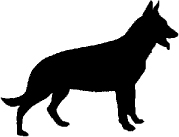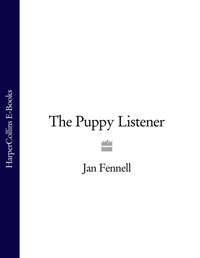
Полная версия
A Dog’s Best Friend: The Secrets that Make Good Dog Owners Great
‘Well, he’s obviously learned something and I’d rather he dug there than in the rose bed,’ she said. ‘Leave him for now.’
This seemed to please George. George admitted to my father that he didn’t enjoy meting out physical punishment. ‘I didn’t like hurting him,’ he said. As the afternoon wore on Rex came over to lie at George’s feet as usual. ‘We understand each other now, don’t we, mate,’ he said ruffling his coat.
George and Rex went on to live a long and happy life together. They were close anyway, but afterwards they seemed even greater pals, happier than ever in each other’s company.
People are not born good dog owners; they need to learn to adapt, to show some thought. Sometimes they also need to admit when they’ve gone wrong. To my mind, what was remarkable about Uncle George was that he admitted he was failing with Rex. Rather than taking it out on the dog, as so many owners of that generation would have done, he applied his mind and came up with another approach.
Like my father, he was an uneducated man. He had left school at twelve, forced by the economic realities of the time to earn a living to help his family. Yet he’d been smart enough to work this situation out and come up with a successful non-violent solution.
It was a long time before I fully understood what he’d tapped into. Eventually I came to see that he had been using positive association to get the message across to Rex. But it was only when I fully understood the true, underlying nature of that positive association that the power of that method really struck me.
Now I understand that as pack-dwelling animals, dogs instinctively see safety in numbers, that they like to work as a member of a team. To be excluded from a pack, as Rex was, is the ultimate punishment to most dogs. In the wild, it can effectively be a death sentence. So to threaten a dog with banishment from a pack, as George had done, is a tool that can produce quite remarkable results.
It was among the most important lessons I have ever been given. And for that, I will always be grateful to dear old Uncle George.

OUR MUTUAL FRIENDS
Why respect is the key to a great relationship with dogs
As most of us know from personal experience, no relationship is ever simple or straightforward. Life, with all its uncertainties, has an unpleasant habit of making sure that difficult times are never far away. For this reason, every relationship needs a few fundamental qualities if it is going to survive all that life has to throw at it.
It was a man called Jim Moss who made me see that this applies as much to our relationship with our dogs as it does to those with our fellow humans. Thirty years ago, in his own quiet way, Jim taught me that the key to any successful relationship can be summed up in one simple word: respect.

Jim and his wife Amy were the most devoted couple you could ever have hoped to meet. I met them in the 1970s, when, with my then husband and two young children, I left London for the Lincolnshire village of Firsby. It was a small, tight-knit community and Jim and Amy were among its most popular figures. A retired couple, both were keen gardeners and walkers, but their greatest passion in life was each other.
You never saw Jim without Amy, or vice versa. They went everywhere together, did everything together. They were also the most polite, kind-hearted people – salt-of-the-earth sorts who’d do anything to help. Everyone thought the world of them.
Occasionally, I would drop in to see them and have a cup of tea. I remember once the conversation got around to marriage – and the secret of their success. ‘We didn’t try and change each other, did we, love?’ Jim said, matter-of-factly. Amy just smiled at him and said, ‘No, we didn’t, did we?’
When the village heard the terrible news that Amy had been diagnosed with cancer at the relatively young age of sixty, a real sense of shock passed through us. We were even more shaken when, within a few short weeks, she died.
The village rallied round Jim, doing the best it could to help him. But, in truth, there was little we could do. In the weeks and months following Amy’s death, it was as if he had disappeared.
While Amy was alive, he had been a familiar face walking up and down the road, always ready for a chat. Now he suddenly became invisible. He was no longer seen in the shop, the church or the pub. I walked past Jim’s house on an almost daily basis, taking my children, Tony and Ellie, to and from the stop where the school taxi collected and dropped them off. The curtains were always drawn. There was never a sound, even of a radio or television. The only sign that Jim was still living there was the garden. Nobody ever saw him out in the garden, yet its lawns were perfectly manicured, its blooms fit for the Chelsea Flower Show. He must be gardening at night or at crack of dawn, we concluded.
One afternoon, during the summer holidays, a couple of years after Amy’s death, Ellie arrived home full of beans.
‘I’ve been talking to Mr Moss,’ she said.
I knew that a child can sometimes be a healing influence on people who are nursing a terrible loss. Their innocence is an antidote to the despair. I was quietly pleased that Ellie had made contact with Jim so left her to it.
A few days later the subject came up again.
‘Mr Moss is such a nice man,’ Ellie announced. ‘I told him that he needed a dog.’
‘Why did you do that?’ I wondered.
‘He’s sad living on his own, isn’t he? Nobody should be alone.’
A few days later, Ellie came in to announce that Mr Moss had come round to her idea.
‘He’d like a dog and wants to talk to you about it,’ she said.
The next day I popped round to see him.
He came to the door and ushered me in. It only took a second to see how terribly he was missing Amy. The house was immaculate, everything sparkled as if it was new. A large photograph of Amy had taken pride of place in the living room. Standing next to it was a vase of fresh flowers from the garden.
‘Is my daughter badgering you to get a dog?’ I asked him.
‘No, no,’ he said. ‘In fact, I think she might be right, I do need a dog.’ At that time, I had a half dozen dogs, mainly English springer spaniels. ‘I’ve seen you with your lovely springers and they seem such good dogs.’
We talked about the pros and cons of owning a dog. He understood that it was a big responsibility. I knew he was a cautious man and wasn’t going to take any rash decisions. I invited him round to my house, to spend some time with my dogs and see if he got on with them.
‘That would be nice,’ he said. ‘I’ll pop round later in the week.’
As it happened, my pack had recently expanded. I’d sold one of my springer spaniels, Ben, to a couple from Sheffield a year earlier. They’d been delighted with him, but then they’d had some bad luck. The husband had a terrible fall and broke his back. They rang me to tell me they could no longer provide him with the active life he needed.
‘Would you have him back?’ they asked.
I agreed immediately, but I knew I couldn’t keep him long term and would have to find a good, new home for him.
Two days after I’d been round to see Jim, he appeared at my front door. I asked him in for a cup of tea, and we sat there talking about dogs. My pack were playing in the garden and I asked them into the kitchen.
It was then that something uncanny happened.
As soon as he arrived in the house, Ben went straight over to Jim and sat down on the floor next to him. Within seconds, Jim was almost instinctively stroking Ben’s neck and head.
‘What’s his name?’ he asked.
‘That’s Ben,’ I said, deliberately avoiding going into any detail.
As we chatted, Jim kept stroking Ben. And the more he stroked him, the closer Ben snuggled up to him. It was a joy to behold.
Jim left after an hour or so, seeming to have enjoyed himself.
‘See you soon, Jan,’ he said as he headed off.
A couple of days later, Ellie, Tony and I were walking back from the school taxi drop-off. As we went past Jim’s house, he was in the window looking out and beckoned to me to wait.
‘Glad I caught you, Jan,’ he said, emerging from the front door. ‘I’ve given it a lot of thought and I think I’d like a dog.’
‘Oh, good for you,’ I said. ‘Have you decided on what breed you’d like?’
‘Well, if I could find a dog like your Ben, I’dbe delighted.’
Ellie shot me a look immediately, but she didn’t need to say anything.
‘Would you like Ben?’ I asked.
Jim was taken aback for a moment or two. ‘Well, I, er,’ he spluttered, not sure what to say.
Finally, I thought it was the right time to tell him Ben’s story. As I explained the situation, Jim’s face lit up.
‘Jan, I’d love to have him,’ he beamed.
Even then, I didn’t want to foist on Jim a dog that wasn’t right for him. So the moment I got home, I put Ben on a lead and walked him round to Jim’s house.
‘I’ll leave you two together for a couple of hours, to see how you get along here,’ I said. ‘I’ll be back to take Ben home later.’
I returned after I’d put the children to bed. I found Ben, snuggled up next to Jim’s armchair, looking every inch as if he was another piece of furniture.
‘So, Jan, could Ben stay?’ he asked simply, stroking Ben once more.
I thought he meant overnight, and so I explained that I didn’t think it would be good for Ben, especially as he’d just got over the upheaval of moving back from Sheffield.
‘Oh, not just for tonight. Can he stay for good?’ Jim said.
Ben was sitting at Jim’s feet now. The pair of them looked as if they were made for each other. I couldn’t help myself as the tears started rolling down my face.
‘Of course he can, Jim,’ I said, when I had eventually regained a little of my composure. ‘I can’t think of anywhere else I’d rather he stayed.’
The transformation was miraculous. About a week after Ben had moved in with Jim, I met a lady in the village shop.
‘I haven’t seen Jim Moss for two years, now I’ve seen him every day this week,’ she said.
Almost immediately, Jim had become one of the familiar sights in the village, striding along with Ben on his lead. Once a week, he and Ben would walk four miles to the nearest market town, where Jim would pop into a pub for a couple of drinks, then do his shopping at the market and walk back home again. He was once more the man he had been before Amy’s death – only now it was he and Ben who were inseparable.
It was many months later that I finally got to have a proper talk with Jim. I saw him in the village and he invited me in for a cup of tea and a chat.
The atmosphere in the house had changed completely from when I had last been there. Before, it was clear that everything was pretty much as it had been when Amy was alive. The house looked as if a woman lived in it – there were knick-knacks and feminine touches everywhere. Now it was very different. Amy hadn’t been forgotten – her picture still dominated the living room, and the flowers were as fresh as ever – but the rest of the house now reflected Jim’s personality rather than hers. He had redecorated and bought new furniture. The knick-knacks had gone and another photograph took pride of place on Jim’s mantelpiece – a lovely portrait of Ben.
Jim was obviously in the mood to talk and, as the tea flowed, he explained how important Ben had been to him. He confirmed what had been obvious to all of us who knew him. For the first two years after Amy’s death, he’d been a lost soul.
‘I hadn’t been able to come to terms with losing Amy. I couldn’t let go of her because I was all alone,’ he said. Ben’s arrival had provided him with company – and the strength finally to let go.
‘I hadn’t been able to grieve properly until I had him,’ he said. ‘When Ben arrived, I was able to start crying. He didn’t laugh at me for doing it, or stumble for the right words to console me. He just sidled up close and was there for me. That dog gave me a reason to live again,’ he told me. ‘Ben showed me my life wasn’t over.’
As so often happens, the dog had opened new doors for Jim. For some reason, people are more likely to strike up a conversation with someone who is walking a dog. And so it proved with Jim.
‘Ben has helped me make a lot of new friends,’ Jim explained. He told me his life was busier than it had ever been.
It was almost overwhelming to hear just how profound an effect this dog had had on Jim’s life.
Jim and Ben’s story has always remained with me, and it is an important one for a number of reasons. I am often asked to sum up what is so rewarding about having a dog. To be honest, it’s something I often find hard to put into words. On many an occasion I have used Jim’s story as the answer. To me, their story says more about the pleasures of owning a dog than any worthy, wordy statement. Jim and Ben were there for each other when it really mattered. And they rewarded each other with all the loyalty and love they could muster. I often think of the two of them walking down the country lanes together. If there’s an image of owner and dog in perfect harmony, then that’s it.
In the years that followed, as I delved deeper into our relationship with dogs, I came to realise he symbolised something more significant. Jim, as far as I was aware, wasn’t someone with experience of living with dogs. Yet, as I’d seen from the moment he and Ben had first met, he seemed to have a natural affinity, they seemed to trust and like him. When Ben had gone to live with him, they had built up a remarkably close bond. And again it seemed to have happened quite naturally. Jim never once came to me for any additional advice on looking after springers. I never heard of Jim attending any of the obedience classes that were popular in the area at the time. He just got on with it – with admirable results.
It was only years later, when I thought about that conversation with him, that it struck me what the key to his success must have been. It came to me when I remembered Jim with Amy all those years before. He had approached his relationship with Ben just as he had treated his marriage to Amy. When Amy had been alive, Jim had respected her. As he’d said himself, he hadn’t tried to change her, to mould her into something she was not. He had let her be herself – and she’d let him be himself.
Essentially, he had done the same thing with Ben. Jim had let his dog be himself and Ben had rewarded his master by allowing him to be himself at a time when he desperately needed to do so. With Ben around, Jim had finally felt free to cry openly and mourn. It was something so natural, yet at the same time so rare.
Of course, as we all know, relationships are not always this simple. Ordinary life can be much more complicated and demanding than this. People do have to change and make allowances for each other – and their dogs have to fit into their life as well. But within Jim and Ben’s story is an essential truth – something that has struck me as more and more important as the years have gone by: respect is the key to all great relationships.

FEELING THE FORCE
The importance of drawing on the lessons of others
Formulating the ideas that make up my method of communicating with dogs was a slow, almost imperceptible, invisible process. There was no real eureka moment, no apples fell from the trees. For years, usually without my realising it, people or events provided me with pieces in a giant jigsaw puzzle. Then one day I looked down to see that jigsaw complete.

The short version of the story is this. As my involvement in the dog world grew through the 1970s and 1980s, I had begun to harbour a deep distrust of traditional training methods. I attended – and even ran – my fair share of classes promoting these views, but I felt more and more that they were too aggressive, too reliant on the domination of the owner and the subjugation of the dog to his or her will. I felt there had to be another way.
The turning point came early in the 1990s, when fate conspired to take me by the hand. It was then that I saw a demonstration by the American ‘horse whisperer’ Monty Roberts. It was an inspiration to see the way he invited the horses to follow him of their own free will, using signals that the animals understood instinctively, rather than resorting to violence or aggressive behaviour of any sort. Monty and his ‘join up’ method set me thinking about whether it was possible to replicate this in dogs, to connect once more with the lost language that man and his best friend shared thousands of years ago.
While I had always been interested in dogs, by now I had begun to see them and their behaviour in a broader historical context, specifically in terms of their relationship with their ancient ancestor, the wolf.
I had discovered that wolf packs operate according to a strict hierarchy, with the Alpha pair as leaders and sole decision makers and the remainder of the pack ranked below according to a strict pecking order. Studying films and documentaries about wolves, I saw that the Alpha pair used four key moments in the day-to-day life of the pack to assert and sometimes reassert their authority. At mealtimes, for instance, they would always eat first. When it was time to go on the hunt, the Alpha pair would lead. At times of perceived danger, the Alphas would either withdraw the pack to safety or confront the threat on their behalf. And, finally, when the pack were reunited after a separation of some kind, the subordinates would pay the Alpha pair some kind of homage, licking frantically at their faces and carrying their bodies and tails lower than their leaders.
At the time, I had a pack of highly intelligent and responsive dogs sharing my life. As I studied the way they interacted more closely, I was surprised to see my own pack indulged in its share of ritualistic behaviour too. Like all dogs, they misbehaved here and there, but they also seemed to do so in a repetitive way, as if there was a pattern to it. As I watched them more closely, I saw striking similarities to the behaviour within the wolf packs. I realised my dogs became most agitated at mealtimes, as we prepared for our walks, when visitors arrived at the house and on my return from work in the evenings. What was more, they interacted with each other in a way that suggested there was a pecking order between them. For instance, my German shepherd, Sasha, seemed to carry herself in a more erect way, as if to keep a distance from the rest of the pack. At other times, she would interact with the rest of the pack, often licking them in a ritualised way. Clearly, the dog had been taken out of the wolf pack, but the wolf pack hadn’t been taken out of the dog. I began to see that my dogs were operating according to the same, hard-wired instincts as their ancestors. There was some kind of hierarchy within the pack and their behaviour was being coloured by it.
The real breakthrough came when I realised they were treating me as part of the pack. At the time, my dogs jumped up at me when I came home, pulled at the lead whenever we went out on a walk, and barked and became agitated when people appeared unexpectedly at the door. I began to wonder whether my dogs believed I too was part of their hierarchy – and whether they saw me as a subordinate member within our pack. Just because I saw myself as being the person responsible for looking after our domestic pack, it didn’t mean that they shared that view. Suddenly, all sorts of behaviour were explained. If my dogs believed they were responsible for me, for instance, the causes of separation anxiety became clear. It was no longer a case of a dog pining for its owner when they were not at home, but one of a frantic parent desperate because it had lost its child and had no idea whether it was safe or not. If there was a eureka moment, then that was the closest I’ve come to it.
From there I began to see that the key to changing my relationship with my dogs lay in removing the mantle of leadership from them and taking it on myself. What was particularly appealing about this was that if I could do this naturally, by using signals that they instinctively understood, they would relinquish this responsibility automatically, they would elect me leader of their own free will. There would be no need for violence, coercion or subjugation. The dogs would simply be listening to their instincts. What’s more, as long as I remained a convincing Alpha, they would follow my lead – again as their instincts told them to.
Slowly, falteringly at first, I began to put together a system of signals, to be used at the four key times so that I could establish myself as leader of my own domestic pack. When we reunited after a separation I made sure we did so on my terms and at a time of my choosing, as a leader would do. I did this by ignoring any attention-seeking, waiting until the dogs calmed down, then calling them to me. In a similar vein I made sure the dogs were calm before leading them out on our walks. At the same time, I began to take charge of situations when there was a perceived danger to the pack. Here, if the dogs barked or got excited at the sign of a visitor at the door, I simply thanked them for alerting me to the danger, thereby relieving them of the responsibility of worrying. Finally, I took charge of mealtimes, taking a mouthful of a snack before laying down the food for my dogs to eat. Again, the idea was that if I was in control of the food then I must be the leader of the domestic pack. Throughout the process, I underscored everything with positive reinforcement, using food rewards to help speed the message that if they did the right thing, good things happened.
It was like watching a minor miracle take place. Over the following weeks and months, I was able to watch as our levels of communication improved beyond all recognition. And their behaviour improved enormously too – as did my enjoyment of life with them. One thing led to another, and soon I found myself using my method to help other people overcome problems with their dogs. By the mid 1990s, I had taken my first tentative steps into full-time ‘troubleshooting’, with my own small business.
It was an exhilarating period in my life. What made it all the more exciting was the way it crystallised some of the important lessons I’d been given earlier in my life. I began to see that in my earlier life I had been given many pointers as to the way ahead. Encounters I had forgotten in the past suddenly began to take on new meanings. The respect I already felt for those wise voices of my youth now grew deeper than ever.
I saw, for instance, the wisdom of old heads such as my Uncle Jim and how right he was in believing we should go along with an animal’s instincts, and to trust its nature to show us the right way to do things. By adopting this philosophy with my own dogs, I had been shown the way ahead. I understood the significance of what Jim Moss had taught me about respecting your dog – and the rewards that flowed from that. I saw too the importance of my cousin Doreen’s idea that dogs have feelings.
At the root of my new-found thinking about how best to get dogs to comply with my wishes, was the idea of dogs’ innate selfishness, the ‘What’s in It for Me’ principle, as illustrated by Uncle George as he persuaded Rex to stay off his rose beds. Now, here I was using the idea that it is far better to work with the dog than against it, using positive reinforcement to underline key messages.









